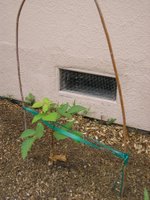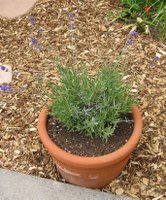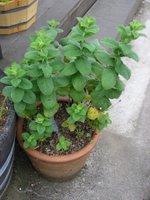"This is not the end. It is not even the beginning of the end. But it is, perhaps, the end of the beginning."--Winston ChurchillI feel pretty energized. I think I'll go garden. There's much to do there, too.
Wednesday, November 08, 2006
I Like Red in the Garden, But I Love Blue in the House
Friday, October 13, 2006
This and That

I also did a little pruning on the Kangaroo Apple shrub along the back fence. It has ripe berries now, although I haven't tasted them yet. The berries are edible when ripe, but poisonous when unripe--I'm not sure how much of a guinea pig I want to be. After pruning the bush, I decided it was the right place to hang a beautiful gourd birdhouse that I bought at the Museum of the American Indian in New York. The gourd is decorated all around with bees and beehive cells--really skilled handiwork.
I also bought some plants and bulbs at the Fall Plant Sale at the Merritt College Landscape-Horticulture Dept. I got three plants and although they're not exactly the best-looking specimens right now, I think they'll do fine when I finally get them placed. I got a flowering
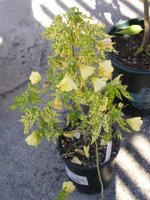 cherry tree (for only $8), a really interesting yellow abutilon with variegated leaves, and a cape gooseberry (its papery husks are shown in the photo at the right). I'm waiting for the flowering cherry to go
cherry tree (for only $8), a really interesting yellow abutilon with variegated leaves, and a cape gooseberry (its papery husks are shown in the photo at the right). I'm waiting for the flowering cherry to go dormant before I transplant it--it badly needs transplanting as it already has roots growing out of the bottom of the pot. I've tucked the potted abutilon away in the back corner of the yard where it will get partial shade. In the winter, when I can finally move the small lilac I stupidly planted there to a sunnier spot, I'll then plant the abutilon in its place. I had to repot the cape gooseberry right away, though. It was clearly root-bound in its one-gallon pot, so I've put it in a five-gallon pot for the time being. I'm not familiar with these plants and I want to watch its growth habits for a while before I place it somewhere permanent. I also picked up 20 more freesia bulbs and ten King Alfred daffodils. I intend to put a lot more bulbs in than that, but there wasn't much of a bulb selection at this sale.
dormant before I transplant it--it badly needs transplanting as it already has roots growing out of the bottom of the pot. I've tucked the potted abutilon away in the back corner of the yard where it will get partial shade. In the winter, when I can finally move the small lilac I stupidly planted there to a sunnier spot, I'll then plant the abutilon in its place. I had to repot the cape gooseberry right away, though. It was clearly root-bound in its one-gallon pot, so I've put it in a five-gallon pot for the time being. I'm not familiar with these plants and I want to watch its growth habits for a while before I place it somewhere permanent. I also picked up 20 more freesia bulbs and ten King Alfred daffodils. I intend to put a lot more bulbs in than that, but there wasn't much of a bulb selection at this sale.There's still a lot more I want to get done in the garden before the rains start (probably in early November if we're running true to form), but I seem to be suffering from a combination of distractedness and procrastination. I guess it's time to pull together a to-do list and get to it.
And yet, perhaps to give myself one more reason to procrastinate in the garden, I've ordered a copy of Henry Mitchell's The Essential Earthman, the first pick for the Garden Bloggers' Book Club started by Carol at May Dreams Gardens. I'm sure when the wet weather hits, I'll be very happy to stay inside with a good gardening book.
Friday, October 06, 2006
Late Bloomers
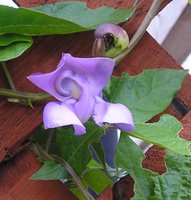 surprised to find some new blooms.
surprised to find some new blooms.The first I noticed were a couple of purple flowers on the Vigna caracalla (snail shell vine) that I planted about 3 or 4 months ago. It was very slow-growing at first, but then it really took off at the end of the summer. It only has a few blooms now--two fully open flowers and several of the twisting, snail-like buds. The Sunset Garden Books says it's perennial and that it should be cut to the
 ground when frost gets to it. It always makes me nervous to cut things back that hard, but I'll try it and see how it comes back next year.
ground when frost gets to it. It always makes me nervous to cut things back that hard, but I'll try it and see how it comes back next year.Also in bloom is a gorgeous pink Watsonia that I got in my class last semester. My instructor brought many divisions of a plant from her yard and offered them to anyone in the class who wanted them. I
 wasn't sure what color it would turn out to be, but I couldn't be happier with the way it turned out.
wasn't sure what color it would turn out to be, but I couldn't be happier with the way it turned out.And the Roma pole beans I planted about two months ago are growing vigorously and flowering. I think I'm still at least two weeks away from being able to harvest any beans but it's good to see things headed in the right direction.
Monday, October 02, 2006
Autumn in New York
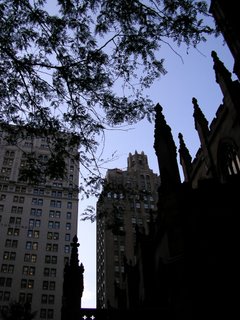
So it seems that while I had my head buried in paperwork, summer ended. When the first day of autumn rolled around I found myself on a plane to New York (Manhattan, to be specific). NYC is a great place to be in the fall. Even though the autumn colors hadn't kicked in yet, there was an interesting patchwork of weather (heat, humidity, wind, some gorgeous blue skies, and a little rain) and a great autumn-y feeling in the air. And even though we spent much of the time indoors seeing a few Broadway shows and visiting some museums, I found there is a surprising amount of nature to be experienced in the city.
While New York may be a concrete jungle, it's not without greenery. Trees line the streets, large planters with lush foliage dot the sidewalks, and rooftop gardens are tucked away high atop the skyscrapers. In many ways, New York does a better job of incorporating trees and plants into the landscape than many suburbs do.
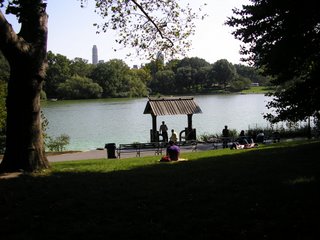
And then there is Central Park, a whopping man-made slice of nature and truly a magnificent respite from the full-on sensory overload of the city. We hardly scratched the surface exploring it and I expect it would take months to really cover all of it.
There are even connections to nature in the most surprising places, like this sculpture in the courtyard outside Trinity Church in Lower Manhattan. Called the Trinity Root, it was cast
 from pieces of the roots of a sycamore tree that stood outside St. Paul's Chapel and was destroyed on 9-11 in the collapse of the World Trade Center towers. It's an amazing piece, stark and tangled, and it seemed like a most fitting memorial to the tree and everything else that was lost that day.
from pieces of the roots of a sycamore tree that stood outside St. Paul's Chapel and was destroyed on 9-11 in the collapse of the World Trade Center towers. It's an amazing piece, stark and tangled, and it seemed like a most fitting memorial to the tree and everything else that was lost that day.So now I'm back home, easing back into real life. Today I was back at my arboriculture class and tomorrow I'll be back in the garden. My friend Karen kept it watered for me while I was away, but there's a lot of weeding, pruning, and planting to do. I also have some tweaking in mind for this blog, beginning with this new look for the new season.
Happy Autumn, everyone!
Saturday, September 09, 2006
A Touch of Blue
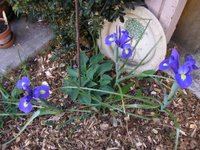 tame. I love the look of the hostas and they bloomed aThe target spot was a little corner bed at the foot of a jasmine vine. It's got a few small hostas and a couple wild geraniums growing there now and in the spring blue dutch iris bloom there as well. When the iris are in bloom, it's a nice shot of color (as shown in this photo from mid-May), but when they're not, it's a little too lot this year, but it wasn't enough. This is also the first thing I see from my kitchen window and I thought it would be nice to have something colorful there even in the winter.
tame. I love the look of the hostas and they bloomed aThe target spot was a little corner bed at the foot of a jasmine vine. It's got a few small hostas and a couple wild geraniums growing there now and in the spring blue dutch iris bloom there as well. When the iris are in bloom, it's a nice shot of color (as shown in this photo from mid-May), but when they're not, it's a little too lot this year, but it wasn't enough. This is also the first thing I see from my kitchen window and I thought it would be nice to have something colorful there even in the winter.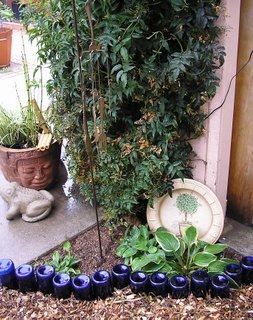
So after about an hour of work (including hacking madly at the jasmine, weeding, and spreading new mulch), I had a dug a trench and planted 15 blue bottles to border the bed. I'm really pleased with the result and I'm looking forward to when I have enough bottles to do another border around BH's garden outside my back steps. I have 9 bottles left and the next border will probably require about 30, so I better start drinking more water.
If you're not familiar with the Path to Freedom blog, you should check it out. They have an amazing family homestead and I'm getting lots of ideas from them for maximizing the planting space I have, creative recycling, and producing a garden that is both beautiful and efficient.
Monday, September 04, 2006
Fighting Global Warming with Free City Trees
"About 375,000 shade trees have been given away to city residents in the past 16 years, and there are plans to plant at least 4 million more. To receive up to 10 free trees, residents simply call the Sacramento Municipal Utility District, a publicly owned power company."
The article discusses the reduction in tree canopies occurring in most major American cities as development has increased. Shade trees can lower summertime temperatures in cities, reduce air conditioning costs, and trap greenhouse gases.
So congratulations to Sacramento. I think we should all be nudging our own cities to follow suit.
Sunday, September 03, 2006
Back to School
My landscape-horticulture classes started about ten days ago. I'd registered for two full-semester classes, knowing that they would probably be more work than I could handle in conjunction with my actual paying work and I would most likely have to drop one class. The first class I went to was Soils Management. I was only about an hour into the class before I concluded that this would be the class I'd have to drop. It was going to involve more chemistry than I am up for at this time. Maybe some other year.
My second class, Arboriculture, started last Monday. Same wonderful instructor that I've had for two previous classes, and many of the same people that were in my last class. The instructor promises that by the end of the semester we will all be primed to become arborists. I'm not sure I want to be an arborist, actually, but it's nice to have options.
What I do hope to get out of the class are three things: First, since we have to pick a tree to do a full tree report on, I think I will do the city-planted tree that is planted at the curb in front of my house. It is the sickest-looking little thing you've ever seen. I'll need to identify the tree and then determine whether it really is sick or suffering from some problem, and if it is, perhaps I can convince the city to replace it with a better tree.
The second goal is to get more information on dwarf fruit trees that I can plant in my back yard. One of our field trips is to a nursery to learn how to pick trees to purchase (and where we'll be able to buy trees wholesale!). Another trip is to the garden of a man who has more than 30 types of fruit trees in his back yard. I hope to get tips on what grows best, how to prune, and how to espalier.
The third goal is to determine what small tree I should plant in my front yard when I re-landscape it. I'll be working on the plant list and plans for that re-landscaping job throughout the winter, and it would be great to know what tree would make the best focal point, so I can plan the rest of the yard around it.
I'm also taking a two-day pruning class in October, which I'm looking forward to. I've just ordered a new pair of Felco #6 hand pruners with a leather holster, so I'll be armed and dangerous very soon.
This semester, it's all about the trees, baby.
Thursday, August 31, 2006
Save the Oaks in Berkeley

In Berkeley the University of California is planning to tear down a woodland grove of Coast Live Oaks (at least one estimated to be 200-300 years old), a massive Bay tree, and several Redwoods. And for what reason? To build a new sports training facility. Sure, that's what the world needs--fewer oaks, more jocks!
 This urban forest is a well-established and thriving ecosystem. Normally, the Coast Live Oaks would be protected under the City of Berkeley's Live Oak Protection Ordinance, but because the university is a state institution, it has declared that it does not need to abide by the local ordinance.
This urban forest is a well-established and thriving ecosystem. Normally, the Coast Live Oaks would be protected under the City of Berkeley's Live Oak Protection Ordinance, but because the university is a state institution, it has declared that it does not need to abide by the local ordinance.An effort has sprung up to persuade the University of California to reconsider. There are at least two other sites that the university could consider for building this new sports facility, but without significant public pressure, it's doubtful that they will revise their plans and leave the oaks in place. If you're interested in joining a grass-roots citizens' campaign to protect this woodland, visit Save the Oaks at the Stadium to learn more and participate in their efforts.
Berkeley is a wonderful, weird place that feels like it's always teetering on the sharp edge between wonderland and an insane asylum. It really needs to hang on to every scrap of nature it can, just to keep it from spinning off the face of the planet.

Sunday, August 20, 2006
Waterworks
 type of container. I've been searching for things to use in the garden that have a bit of an Old California look, which means a Mexican style (which is influenced greatly by Spanish style, which is influenced greatly by Moorish style, etc.), but I couldn't find a glazed pot with no drainage hole in that style. The closest I could find was a large pot at Cost Plus for about $25. It looks to me like it's Southeast Asian in style (Indonesian perhaps, or Thai), but the face on the pot reminded me slightly of the Mayan face carvings I saw years ago in the Yucatan area. At any rate, it was interesting, the right size, and the right price, so I got it.
type of container. I've been searching for things to use in the garden that have a bit of an Old California look, which means a Mexican style (which is influenced greatly by Spanish style, which is influenced greatly by Moorish style, etc.), but I couldn't find a glazed pot with no drainage hole in that style. The closest I could find was a large pot at Cost Plus for about $25. It looks to me like it's Southeast Asian in style (Indonesian perhaps, or Thai), but the face on the pot reminded me slightly of the Mayan face carvings I saw years ago in the Yucatan area. At any rate, it was interesting, the right size, and the right price, so I got it.I set the fountain up a few months ago, using a pot of horsetail reed as the only plant in it. It looked a little bare. And I'm afraid I was a little slipshod about the maintenance recently, resulting in a lot of nasty algae building up. A pond with algae loses much of its appeal, although Linus the cat seemed to like playing with the gross green scum floating around in it.
So this weekend I made it my mission to improve the fountain. In order to make it look a bit more lush I purchased a variegated acorus to go beside the horsetail. This morning I took the whole thing apart, scrubbed it out, and reassembled it. This is the result:
 You will notice the slightly handicapped concrete frog to the right of the fountain. This frog used to reside in my grandmother's backyard in a little grotto that my grandfather built in the corner. When I was about nine, we moved to a house that had a pond in the backyard that had been filled in. We spent an Easter vacation digging out the pond, cleaning it up and refilling it with water and fish, and then my grandmother brought the frog over to stand guard at the edge of the pond. When we moved
You will notice the slightly handicapped concrete frog to the right of the fountain. This frog used to reside in my grandmother's backyard in a little grotto that my grandfather built in the corner. When I was about nine, we moved to a house that had a pond in the backyard that had been filled in. We spent an Easter vacation digging out the pond, cleaning it up and refilling it with water and fish, and then my grandmother brought the frog over to stand guard at the edge of the pond. When we moved from that house several years later, the frog went back to my grandmother's house, where in an unfortunate accident the gardener accidentally amputated its forearms with a weed-whacker. After my grandmother died and the family was closing up her house, I brought the frog back to my apartment where it lived in a cramped hallway (and then after I'd stubbed my toe on it a few times, in an even more cramped closet) until I moved to this house four years ago. At long last, the concrete frog, now named Venus de Frog-o, has found another pond to stand guard at.
from that house several years later, the frog went back to my grandmother's house, where in an unfortunate accident the gardener accidentally amputated its forearms with a weed-whacker. After my grandmother died and the family was closing up her house, I brought the frog back to my apartment where it lived in a cramped hallway (and then after I'd stubbed my toe on it a few times, in an even more cramped closet) until I moved to this house four years ago. At long last, the concrete frog, now named Venus de Frog-o, has found another pond to stand guard at.
Saturday, August 19, 2006
First Blush and a Second Try
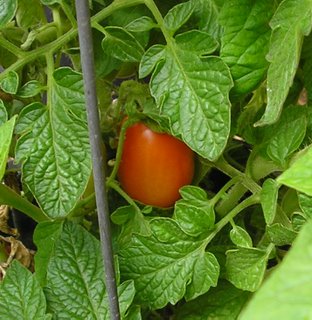 The volunteer tomatoes, which appear to be Roma, are finally starting to color up. The three plants don't have much fruit at all so far--not much more than a dozen tomatoes on each plant, and only a few more flowers. Pretty slim pickings compared to past years. I don't like tomatoes, so I say this with much less disappointment than most tomato-growers would feel. Still, it would be nice to get enough to pass on to friends and family and still make a bit of sauce to freeze.
The volunteer tomatoes, which appear to be Roma, are finally starting to color up. The three plants don't have much fruit at all so far--not much more than a dozen tomatoes on each plant, and only a few more flowers. Pretty slim pickings compared to past years. I don't like tomatoes, so I say this with much less disappointment than most tomato-growers would feel. Still, it would be nice to get enough to pass on to friends and family and still make a bit of sauce to freeze.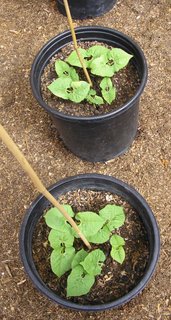
I have tried a couple times to grow Roma bush beans and each time the results have been dismal--small, stunted bushes with just a few itty-bitty, curled up beans. Now I'm trying Roma pole beans (recently delivered from Pinetree Garden Seeds). I planted two 5-gallon containers with the seeds a week ago and another five poles of them in the ground in between the roses. The ones in the ground are barely making an appearance, but those in the containers are growing well. I should be able to harvest beans by early October, which would give them about a full month to keep producing before the weather significantly cools.
Sunday, August 13, 2006
More August Crap
Hanna attributes her current situation to the effects of the summer heat and lack of planning. Both those phenomena have contributed to my garden's lackluster state. But I have to admit to a third category as well: gardener errors. In fact, I seem to spend a lot of my gardening time wondering what bonehead thing I'm going to do next.
One case in point is the sweet peas. I planted them late (error #1), I didn't pinch them back (just learned about doing this on a gardening show this morning--error #2), I let them get overwhelmed first by volunteer tomato seedlings and later by poppies (error #3), and I didn't act when I noticed that they were getting hit by powdery mildew (possibly due to being up against a stucco-covered wall that held on to the moisture--error #4). The result was this:
 I had hoped this entire wall would be covered with sweet peas, but the results have been a few scraggily vines and less than a dozen blooms so far. I'll be ripping them out soon. I may try to grow a late crop of haricot verts in their place, although I may find that they will have all the same problems.
I had hoped this entire wall would be covered with sweet peas, but the results have been a few scraggily vines and less than a dozen blooms so far. I'll be ripping them out soon. I may try to grow a late crop of haricot verts in their place, although I may find that they will have all the same problems.There are more problem spots I could show, and I will, but not today. It's too depressing. There are a few successes as well. The passion flower vine is now healthy and full and steadily putting out a couple new blooms every day. The salvia is growing like crazy (actually, it's taking over the strawberry bed) and it's attracting hummingbirds. The roses are blooming, not exactly abundantly, but better than in past years. The clematis is done blooming now but it was spectacular and I look forward to more of the same in future years.
Hanna listed three things she was going to do to try to correct her August garden situation in the future: 1) cruise the neighborhood to see what's blooming in the area and include those plants in her garden, 2) plant more annuals, and 3) incorporate more colorful foliage. Those are all good ideas and I'm going to try to follow her lead. But I also have to remind myself that I am planting more perennials in my garden each year, and that each year things will grow more established, more colorful, and eventually more lush.
Monday, August 07, 2006
The Forgiving Fuchsia
 These first fuchsia blooms are evidence that gardening can be a very forgiving endeavor if you're just patient enough. Last summer I took a cutting from a fuchsia in my friend Mark's garden, stuck it in some rooting hormone and popped it in a six-pack filled with potting soil. I kept it watered in semi-shade and it did ... well, pretty much nothing. After a few months of no growth I thought it might do better if I transplanted it to a 4-inch pot, but
These first fuchsia blooms are evidence that gardening can be a very forgiving endeavor if you're just patient enough. Last summer I took a cutting from a fuchsia in my friend Mark's garden, stuck it in some rooting hormone and popped it in a six-pack filled with potting soil. I kept it watered in semi-shade and it did ... well, pretty much nothing. After a few months of no growth I thought it might do better if I transplanted it to a 4-inch pot, but  in a moment of bleary-eyed gardening I accidentally planted it in a pot filled with straight composted manure instead of potting soil. (Don't try this at home.) I can't remember how long it was before I realized my mistake, but I know it was a matter of weeks. By the time I figured out what I'd done and went to repot it, it looked exactly the way any of us would look if we'd been stuck in a pot of manure--shocked, to say the least. I thought for sure it was ultimately destined for the compost bin, but I put it in a 4-inch pot of potting soil anyway and watered it and just left it alone. About two months ago I noticed some new growth and repotted it again, this time in a plastic pot inside a ceramic pot with no drainage hole, so it stays more evenly moist. Happy at last, the plant shot up and out and put on buds. I am redeemed.
in a moment of bleary-eyed gardening I accidentally planted it in a pot filled with straight composted manure instead of potting soil. (Don't try this at home.) I can't remember how long it was before I realized my mistake, but I know it was a matter of weeks. By the time I figured out what I'd done and went to repot it, it looked exactly the way any of us would look if we'd been stuck in a pot of manure--shocked, to say the least. I thought for sure it was ultimately destined for the compost bin, but I put it in a 4-inch pot of potting soil anyway and watered it and just left it alone. About two months ago I noticed some new growth and repotted it again, this time in a plastic pot inside a ceramic pot with no drainage hole, so it stays more evenly moist. Happy at last, the plant shot up and out and put on buds. I am redeemed.
Sunday, July 30, 2006
The Mesclun That Was
Today when I went out to water barely any of the lettuces were left:

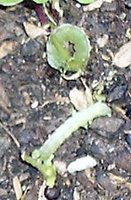 When I got up close and personal I found that an entire of colony of little green caterpillars were going to town on the last few bits of plant life remaining. I'm not sure what they are (cutworms maybe?) but it looked like they'd brought the kids and a large contingent of their extended family and all were having a swell picnic in my pot of mesclun. Well, there's no better way to end a picnic than with a swim. I spent the next fifteen minutes scooping them out one by one with a fork and drowning them in a container of hot soapy water. I hope I got them all because I hate to split up a family.
When I got up close and personal I found that an entire of colony of little green caterpillars were going to town on the last few bits of plant life remaining. I'm not sure what they are (cutworms maybe?) but it looked like they'd brought the kids and a large contingent of their extended family and all were having a swell picnic in my pot of mesclun. Well, there's no better way to end a picnic than with a swim. I spent the next fifteen minutes scooping them out one by one with a fork and drowning them in a container of hot soapy water. I hope I got them all because I hate to split up a family.Does anyone know of any other ways to take care of these creepy things? Would diatomaceous earth work?
Thursday, July 27, 2006
Thank You, Sir, May I Have Another?
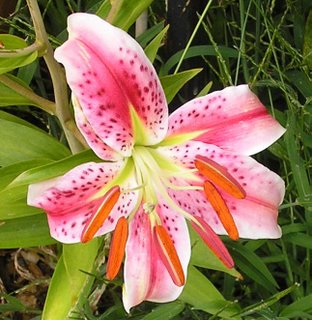 One thing I definitely hope to add more of in my garden is oriental lillies. I think they're spectacular--the scent, the splashy color, the slightly ruffled edges to the petals. I like all of it. I started with just two Stargazer lillies planted earlier this year and the first buds on one of them has just opened. I think the buds got a little toasted in the recent heat wave, so they aren't perfect, but still ... wow!
One thing I definitely hope to add more of in my garden is oriental lillies. I think they're spectacular--the scent, the splashy color, the slightly ruffled edges to the petals. I like all of it. I started with just two Stargazer lillies planted earlier this year and the first buds on one of them has just opened. I think the buds got a little toasted in the recent heat wave, so they aren't perfect, but still ... wow!And I'm not the only one who loves them. My cat Linus greeted me today with his white mustache dyed orange from the lilly's pollen. Apparently he finds the scent irresistable too.
Black Spots on the Pepper?
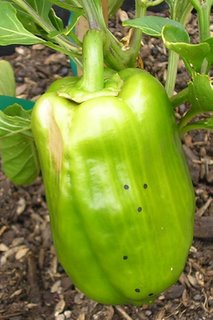 While checking on the progress of the bell peppers this morning, I noticed several tiny black spots on one of them. Since there are only two peppers so far, any sign of trouble is worrisome. I've never seen something like this. Anyone know what the spots are? Pest? Disease? Tiny freckles from too much sun?
While checking on the progress of the bell peppers this morning, I noticed several tiny black spots on one of them. Since there are only two peppers so far, any sign of trouble is worrisome. I've never seen something like this. Anyone know what the spots are? Pest? Disease? Tiny freckles from too much sun?Please advise!
Monday, July 24, 2006
How Do You Spell Relief? F-O-G!
During the heat wave I did nothing in the garden except try to keep things watered enough. I can usually get by watering every third day. When things get warm, I need to kick it up to every other day. But between the extreme heat and the sandy soil here, even that wasn't enough. On Saturday in an effort to be a little more environmentally friendly, I tried to redirect the water outflow from my washing machine into a few 5-gallon buckets to water the yard with. I learned two things by doing this: 1) My tiny, supposedly water-efficient washing machine still uses more water than I thought (somewhere around 25 gallons for one load); and 2) it's really easy to flood my laundry room. I'll need to rig up something a little more error-proof if I want to do this again.
One garden-related thing that I did do recently is join a few friends from my landscape-hort class to tour a couple gardens created by Keeyla Meadows, a landscape designer and artist in nearby Albany. The gardens were amazing--lush and colorful, lots of different textures and layers of planting, and some really fun sculptures tucked in for added zing. Seeing her gardens, I was reminded that I need to plant more densely and use more of each plant for greater impact. My tendency is to just put one plant here and another plant there and the result is that nothing really stands out. I wish I could post pictures from the tour but I forgot my camera (doh!). But do click the link above to check out Keeyla's web site and see some samples of her garden design. Thanks to Keeyla for graciously allowing us to visit, and thanks to Yuriko for setting it up!
Wednesday, July 19, 2006
An Inconvenient, Scary-As-Hell Truth
Let's put aside the issue that if the 2000 election had been settled by the voters instead of the Supreme Court we would have Al Gore, an intelligent, thinking man, in the White House instead of the inarticulate, simple-minded, chancellor-groping frat boy who currently resides there (when he's not playing cowboy in Texas). It's possible that Al Gore may actually have a more lasting and significant impact on the world by not being president and by instead doing exactly what he's doing now--explaining over and over again to audiences all over the world about the grave peril we face from global warming, how it is caused, how it is measured, what will happen if we do nothing, and what we can do in our own lives, every day, to make a difference.
There was so much good, clear information presented in the film and many experts have verified that the science behind it is very solid. The film uses terrific--and in some cases, terrifying--graphics to make clear exactly what is at stake. The part that hit me hardest was seeing a series of computer projections of how land maps will be redrawn over the next century by rising sea waters caused by melting glaciers. I watched a map of the San Francisco Bay Area completely change before my eyes as waters swept over much of the perimeter of San Francisco, Oakland, Berkeley, and Marin County. And Alameda? Alameda will be completely underwater. My hometown erased--it doesn't get much more personal than that.
I won't go into a lot of detail about the issue--there's plenty of information out there and the movie has a great web site at www.climatecrisis.net with lots of suggestions for how each of us can take action. But begin with this: If you haven't seen the film, click the pledge icon on the right side of this blog page, and commit to seeing An Inconvenient Truth as soon as you can. (If you live outside of the U.S., click here for release dates overseas.) There is much to be done--and to undo.
Can You Name This Plant?
 Once again, I call upon the collective wisdom in the gardening blogosphere to help me identify another volunteer plant in my garden. Here it is.
Once again, I call upon the collective wisdom in the gardening blogosphere to help me identify another volunteer plant in my garden. Here it is. It currently stands about 18-20 inches high. It has tiny white blossoms and it's also showing some signs of leaf curl (that alone makes me think I should yank it, but I'd still like to know what it is first). Any guesses?
It currently stands about 18-20 inches high. It has tiny white blossoms and it's also showing some signs of leaf curl (that alone makes me think I should yank it, but I'd still like to know what it is first). Any guesses?
Bloom Report
 Finally! An actual sweet pea! I planted these seeds on April 25, so it took almost three months to get to this point. I thought they would grow much faster, but so far the tallest plants are only about 3 feet high and there aren't very many buds. It might be that
Finally! An actual sweet pea! I planted these seeds on April 25, so it took almost three months to get to this point. I thought they would grow much faster, but so far the tallest plants are only about 3 feet high and there aren't very many buds. It might be that this spot does not get quite enough sun. Can anyone tell me if these reseed themselves easily, or do I need to make a point of saving the seeds?
this spot does not get quite enough sun. Can anyone tell me if these reseed themselves easily, or do I need to make a point of saving the seeds?The red oriental poppies are blooming away now and one of the plants has white spots in the center, which make them even more attractive. I think poppies are going to be permanent residents in my garden.
Monday, July 17, 2006
Where Is Our Bob Flowerdew?
So it got me to wondering: where is our Bob Flowerdew? Does NPR even have a gardening show? If they do, I've never heard of it. If they did, I might finally start listening to NPR. (None of my friends can understand why I don't listen to NPR, since the fact that I'm a frequent viewer of PBS and a news junkie in general would seem to make me an ideal NPR devotee. The reason I don't listen? Those monotone, droning voices! Those NPR parodies that Saturday Night Live did a few years back were just a bit too spot on.)
But getting back to Bob Flowerdew ... I think the reason we don't have a Bob Flowerdew here in the U.S. (and no, as much as I like Paul James, I don't think he has nearly the kind of celebrity status or industry following that it sounds like Flowerdew has) is that Flowerdew has something in the U.K. that nobody in the USA has--a significant audience. According to the Post, "Gardeners' Question Time" has an audience of 2 million in a country of 60 million. To translate that kind of audience to the U.S. (with a population of 299 million), a gardening guru would have to have an audience of 10 million. According to USA Today, that would be equal to the audience of last week's #2 top-rated broadcast TV show (god help us), "So You Think You Can Dance."
There's been a lot of talk in the garden blogs of late, particularly at Garden Rant, that gardening is really a much more popular pastime in the U.S. than is commonly believed. Well, bless them for the thought, but I am doubtful, at least about how things currently stand. There are some hopeful signs, however. People are becoming increasingly aware of the dangers of pesticides and the growing demand for organic produce is bound to drive some people into their gardens. But I still see the time crunch that most Americans live with and the ridiculous prices for homes and land in urban/suburban areas to be the main factors that keep most people from gardening.
Is it possible, though, that if there was an American Flowerdew--someone knowledgeable, funny, charismatic, and (it goes without saying) organic--that he could be the pied piper to seduce more of us into taking up the shovel and rake? That he (or she, of course) could actually grow the audience?
Well, maybe. But that's really one of those "chicken or egg" questions, and hen blogging is beyond my purview.
Friday, July 14, 2006
Vegetable Sitings
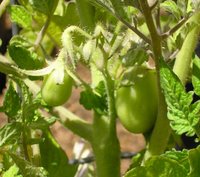 It's not just a slim hope anymore. Actual vegetables have appeared in my garden. Everything seems to be happening so late this year and the plants themselves are much smaller than in previous years, so I was doubtful that there would be anything to harvest at all.
It's not just a slim hope anymore. Actual vegetables have appeared in my garden. Everything seems to be happening so late this year and the plants themselves are much smaller than in previous years, so I was doubtful that there would be anything to harvest at all.Each of the three tomato plants has a couple of tiny tomatoes. There are quite a few more buds and I think I might go out there with a soft little paintbrush and try to help the pollination process along a bit. Can't hurt, I guess.

There is also one pepper on one of the bell pepper plants. These plants are rather puny so I'm surprised that one is producing at all. This weekend I'm going to give everything a shot of fertilizer and see if it helps.
On the other hand, I'm ready to declare the corn a failure and toss the pathetic little shoots in the compost bin. I have some cabbage seedlings to transplant soon, and I'm anxiously awaiting the arrival of my seed order from ContainerSeeds.com. I'm looking forward to trying the Super Marconi pole beans (instead of the Roma bush beans I've repeatedly tried and failed with) and the "perpetual spinach" chard.
I'm hoping that we'll have a long Indian summer this year to make up for the dismal spring, so that I'll still have time get some actual crops going instead of one pathetic little plant here and another one there. I feel like I'm giving new meaning to the term "micro farming"--as in "microscopic harvest."
Thursday, July 13, 2006
Urban Outsiders
 I've been a fan of James' British show "The City Gardener," which HGTV has been airing lately. The idea is that he takes small, completely neglected urban spaces (usually they're more of a courtyard than a yard) and transforms them into rather lush, relaxing retreats for their owners (who generally haven't got a clue about anything related to gardening). The new American show, "Urban Outsiders," seems to be exactly the same format and the American homeowners are equally clueless.
I've been a fan of James' British show "The City Gardener," which HGTV has been airing lately. The idea is that he takes small, completely neglected urban spaces (usually they're more of a courtyard than a yard) and transforms them into rather lush, relaxing retreats for their owners (who generally haven't got a clue about anything related to gardening). The new American show, "Urban Outsiders," seems to be exactly the same format and the American homeowners are equally clueless.Although the garden designs on "The City Gardener" seemed to me to lack variety (in the style/design, that is, not in the plants) and the "Urban Outsiders" debut show tonight seemed to be following the same pattern, I like James' shows because he's clearly crazy about plants. And he does something that few designers on HGTV (and perhaps in real life as well) seem to do--he considers the needs and wants of the clients and designs accordingly.
And he's cute.
And I admit it--I'm a sucker for the accent.
Give the show a try.
Wednesday, July 12, 2006
Keeping On Keeping On
 No major happenings (good or bad) going on in the garden these days. I seem to be lacking either the time or the energy to tackle any of the myriad projects I have in mind, so I'm just doing the 3 W's: watering, weeding, and wandering around aimlessly thinking that I should be getting more accomplished.
No major happenings (good or bad) going on in the garden these days. I seem to be lacking either the time or the energy to tackle any of the myriad projects I have in mind, so I'm just doing the 3 W's: watering, weeding, and wandering around aimlessly thinking that I should be getting more accomplished.This is all I have to show for my efforts today. I weeded BH's garden, cut back the bleeding hearts, and planted some catmint that I bought about a week ago. This bed doesn't look like much right now because everything has bloomed out and I'm waiting for the iris and the freesia to completely die down. But there's a stargazer lilly shooting up in the back and hopefully the catmint will fill out quickly. Any suggestions for some compact, late summer bloomers I can fill in with?
Friday, July 07, 2006
Poppy!
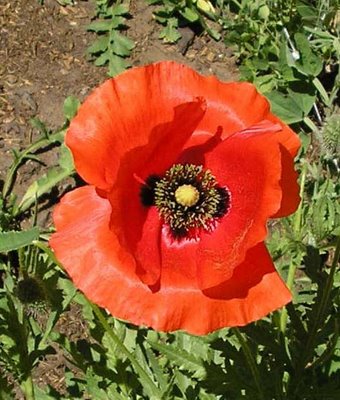
I was beginning to think they'd never bloom. But this morning I went out back to find this beautiful poppy. Just the one bloom so far, but there are several more buds on this plant. I sowed seeds for both Shirley Poppies and Oriental Poppies in this bed. I believe the black splotches at the center mean this is an Oriental.
Tuesday, July 04, 2006
Corner Bed Makeover--Part One
While I was at it, I ended up ripping out the nasturtiums too. I do this a lot with nasturtiums and I've come think of it as normal. I like nasturtiums but I find that just at the time they fill out and bloom heavily, they also manage to look scraggily at the same time. I started out just cutting them back, but I got a little carried away and they all found their way into the green recycling bin. There were many seeds left behind so I know they'll come back and that's fine with me.
Today I completed the clean-up. The bed is now completely weeded for the first time this year. And Linus the cat, who has lost his little jungle hang-out, is not happy. This is what the bed looks like now:
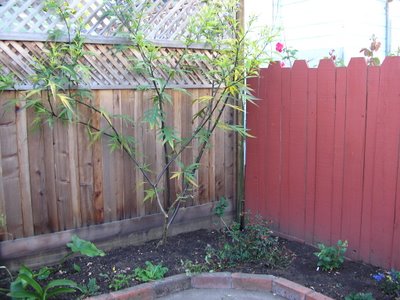
What's left there now are (from left to right): an amaryllis, a calla, three primroses, the nightshade shrub/tree, a wild geranium, a cigar plant (Cuphea ignea), a lilac (which will be moved to a sunnier spot in the winter), a Phygelius macrophylla, and some lobelia that has sprung up at the base of a rose. Obviously, I need some taller plants in the back, so I bought some amaranth seeds (Love Lies Bleeding) to plant there and I'm going to try some pole beans up along the fence. I plan to transplant a couple of nicotiana and some dianthus that I have in pots into the middle part of the bed. But I'm getting ahead of myself--that's Part Two of the makeover.
Sunday, July 02, 2006
Massive Mystery Plant Identified
 But it drops seed pods constantly, far more than I can keep up with, and it isn't actually one plant in this corner, it's several. It's like seeing enemy forces on the horizon in ever-increasing numbers.
But it drops seed pods constantly, far more than I can keep up with, and it isn't actually one plant in this corner, it's several. It's like seeing enemy forces on the horizon in ever-increasing numbers.So I pruned off a branch and headed over to my favorite nursery in Alameda, Thomsen's Nursery, to ask for help. They immediately identified the genus--Solanum--and warned me that it was in the same family as nightshade and probably poisonous.
When I got home, I checked the Sunset Western Garden Book and the Internet and was able to narrow it down further to Solanum aviculare, also known as Kangaroo Apple. It's described as an evergreen shrub, native to Australia and New Zealand, that grows fast to 6-10 feet (I can testify to that!). The flowers and foliage are indeed poisonous, although it apparently has edible, though not necessarily tasty, fruit in the fall. And this is really interesting--it is used in the pharmaceutical industry as a source of steroids. I believe it. This plant acts like it's on steroids--pumped up and aggressive.
So once again, I'm faced with the question: Does it stay or does it go? I think I already know the answer, but Linus isn't going to like it.
Almost Blooming
 Things are at a sort of in-between stage in my garden in terms of flowers. Of course, the old stand-bys, like the geranium and the nasturtium, are still shooting out blossoms at a steady rate. But most everything else seems to be between shifts. The bulbs are through for the year, the roses have buds but no flowers at the moment, the sweet peas are being dreadfully slow about growing up at all.
Things are at a sort of in-between stage in my garden in terms of flowers. Of course, the old stand-bys, like the geranium and the nasturtium, are still shooting out blossoms at a steady rate. But most everything else seems to be between shifts. The bulbs are through for the year, the roses have buds but no flowers at the moment, the sweet peas are being dreadfully slow about growing up at all.But then there are a few things just about to open that have really captured my interest. One of the foxgloves that I planted this spring is shooting forth a white spire of buds. I thought foxgloves only bloomed in their second year. Could I have a prodigy on my hands?
 Then there is the canna. I got this as a start this spring in my landscape hort class (one of the benefits of this program is that teachers and students alike are happy to share their bounty). I didn't know what color it would be, or whether it was a dwarf canna or standard-sized. But now I see a bright red bloom ready to explode and I can't wait to see how it develops.
Then there is the canna. I got this as a start this spring in my landscape hort class (one of the benefits of this program is that teachers and students alike are happy to share their bounty). I didn't know what color it would be, or whether it was a dwarf canna or standard-sized. But now I see a bright red bloom ready to explode and I can't wait to see how it develops.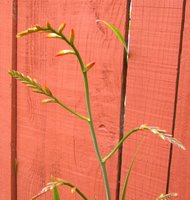
And finally, there is yet another volunteer, although this is one have in the garden. I don't know whether it crept under the fence from my I'm happy to neighbor's yard or was planted by birds, but it's had me curious for a few months now. Before the bud appeared I feared it was going to be a gladiola. I can't stand gladiolas since I can't help but think of them as funeral flowers. But it looks now like it's a crocosmia, and I'm anxious to see exactly what shade these tight, orange-red buds open to.
Wednesday, June 28, 2006
Container Vegetable Garden
I'm doing this on a very limited scale already. I've been growing mesclun, spinach, tomatoes, and carrots in containers. I also have a couple sweet peppers and a couple Roma bean plants in containers too, although they're not doing too well so far. Today I pulled out the last of the spinach, which had bolted, and replanted the same container with more mesclun. I also sowed some more Round Romeo carrot seeds around the perimeter of the container where the berry plant is growing.
I'm trying to find whatever information I can on what varieties of vegetables would grow best in containers and I think I found a great resource: ContainerSeeds.com. They offer an impressive array of vegetables that are well-suited to containers, along with information about the size of container that is best for each plant. I think I'll be placing an order soon.

I also did something yesterday that will probably turn out to be very smart or a waste of money. I bought a small (quite small) greenhouse on ebay. It's a plastic-covered, 5-shelf structure that's roughly 6' tall, 2' wide, and 1.5' deep. Hopefully, it will be just big enough to keep some lettuces going year-round and get an early start on spring seedlings. Including shipping, it's $55. If it works out, it should pay for itself in a couple years.
Mystery Plant Identified
So now the question is: Do I yank it, re-locate it, or just leave it?
Tuesday, June 27, 2006
My First Carrot
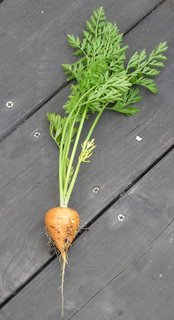 I harvested the first carrot today. These are Round Romeo carrots from a packet of Renee's Garden seeds. I realized today that it had been more than two months since I sowed the seeds (April 18th) and the seed packet says 60 days to maturity. So I plucked out the tallest of the greens and found a nice round, orange globe more than an inch in diameter.
I harvested the first carrot today. These are Round Romeo carrots from a packet of Renee's Garden seeds. I realized today that it had been more than two months since I sowed the seeds (April 18th) and the seed packet says 60 days to maturity. So I plucked out the tallest of the greens and found a nice round, orange globe more than an inch in diameter.Because I only pulled up the one carrot, I didn't bother to cook it, just cleaned it and chomped it down. It was really tasty--nice and sweet.
I'll give the rest of the batch (which was not very big to begin with) another week or so, then harvest all of them together. They'll be really delicious steamed with butter.
These are a really good option for container planting since you don't need a very deep container. There are still a lot more seeds in the packet, so I'm looking forward to growing many more of these babies.
Blossoms on the Mystery Plant
Friday, June 23, 2006
Can You Name This Plant?
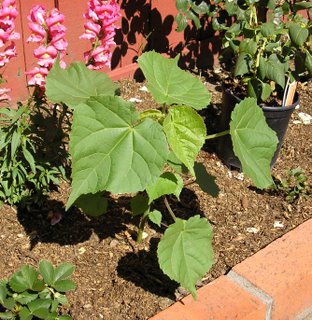 Let's play this oh so fun game once again!
Let's play this oh so fun game once again!This volunteer plant seems to be very happy, sending up large, thin, heart-shaped, slightly hairy leaves. The plant is about 12 inches high now. I don't see any buds yet. Oh, and the whiteflies are enjoying it.
I did wonder if it was a melon plant because last year I planted a melon vine just a few feet from this spot and I thought a seed might have gone astray. But I can't remember exactly what those leaves looked like and I don't see any sign of this plant vining yet.
Can you name this plant?
Monday, June 19, 2006
First Salad
I checked my postings to see when I planted the mesclun seeds, but it looks like I forgot to mention when I did it. To the best of my recollection, I planted them around May 18th, which means it was a month from seed-sowing to harvest. I want to keep track of that because I want to see if I can keep them growing year-round and I'll need to know how often I need to re-seed.
Sunday, June 18, 2006
The Ultimate Seed-Saver
I can't decide whether I'm depressed to think that we're so close to doomsday that this kind of facility is necessary, or relieved that someone is making plans to survive it. Probably the former, but maybe I'll feel better after a little gardening...
Friday, June 16, 2006
A Salvaged Garden

I went to Urban Ore in Berkeley a couple days ago and went home with two great finds. One is a white-and-rust metal hanging planter. My plan is to let it get completely rusty and use it as a
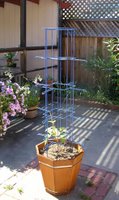 centerpiece in the area that is now my vegetable bed. In the fall I plan on re-doing that entire bed and I think that this planter mounted on a pole or post of some kind in the center of the bed will look great.
centerpiece in the area that is now my vegetable bed. In the fall I plan on re-doing that entire bed and I think that this planter mounted on a pole or post of some kind in the center of the bed will look great.My other find was a blue metal store display rack of some kind. It caught my eye because it's such a terrific shade of blue, but I knew right away it would make a great trellis for the mystery berry plant I was going to pot and re-locate. Here it is happily soaking up the sun in a new redwood pot.
Bye-Bye Tomatoes
 Yesterday afternoon I began the tomato relocation effort. After scrounging a couple dozen 5-gallon and 1-gallon plastic pots (thank you, Magic Gardens Nursery) and purchasing three big bags of potting soil to be mixed with compost, I began digging up and potting some of the biggest plants. After putting three plants in 5-gallon pots, I realized that it was going to cost me a fortune in potting soil to pot all of the tomato plants--and then I'd have to find homes for most of them. Forget it. I decided that the rest of them would make a lovely addition to my compost bin and I began yanking them out with something I can only describe as glee.
Yesterday afternoon I began the tomato relocation effort. After scrounging a couple dozen 5-gallon and 1-gallon plastic pots (thank you, Magic Gardens Nursery) and purchasing three big bags of potting soil to be mixed with compost, I began digging up and potting some of the biggest plants. After putting three plants in 5-gallon pots, I realized that it was going to cost me a fortune in potting soil to pot all of the tomato plants--and then I'd have to find homes for most of them. Forget it. I decided that the rest of them would make a lovely addition to my compost bin and I began yanking them out with something I can only describe as glee.
The result was a nice orderly bed with room for the plants I really wanted. The sweet peas, about 8 or 9 inches tall, will now get the sun they need and hopefully a growth spurt. The poppies will have a little room to spread too. A couple liriope have started to make an appearance and there are a few mystery plants as well that I left in place until I can identify them. Then I was able to add some newcomers. In the far left corner of the bed I planted a small climbing shell vine that I'm hoping will grow up and fill the lattice work of the fence to give a little privacy. And I planted two angel trumpets, which I want to train into tree-like shapes, also to give a little privacy along that fence. And to fill in the empty spots, I sowed some crackerjack marigold seeds.
I dare the tomatoes to come back.
Wednesday, June 14, 2006
Tomato Surprise
Yes, I should have realized that was what they were. I've had volunteer tomatoes come up in the same area where I'd planted them the previous year, but I've never grown tomato plants in this bed. And I never would have imagined that so many volunteers would sprout--there must be between one and two dozen plants. They've actually come up more successfully than the seeds I planted there myself! I can only assume that it is the result of racoons having late-night picnics in my yard.
Today I spent an hour or so potting up a berry plant, two roma bush beans, and two bell pepper plants. But in the next few days, I'll be digging up all of the tomato plants and potting them up. I guess I'll keep a few and try to find nice homes for the rest. As if there isn't enough to do in the yard, now I'm running an adoption service for vegetables!
Sunday, June 11, 2006
In Pursuit of Farm Fresh Produce
 I don't think the local farmers or grocers need to worry about competition from my little garden, but this morning I had my breakfast yogurt topped with a few strawberries from the new Ogallalla strawberry plants I got from Gurney's this year, and it was sweet. Actually, the experience of growing the berries may have been sweeter than the eating, which led me to do a mid-season review of whatever edibles I'm growing right now.
I don't think the local farmers or grocers need to worry about competition from my little garden, but this morning I had my breakfast yogurt topped with a few strawberries from the new Ogallalla strawberry plants I got from Gurney's this year, and it was sweet. Actually, the experience of growing the berries may have been sweeter than the eating, which led me to do a mid-season review of whatever edibles I'm growing right now.Strawberries

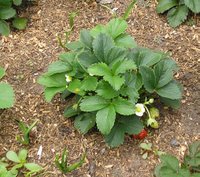 With somewhere between 60 and 70 everbearing strawberry plants now, I would have expected to have a bit heavier and a bit more consistent harvest. But so far the strawberries are trickling in. The Ogallalla berries, which are in two strawberry pots, are the only ones that have ripened so far and overall, they are not nearly as sweet and not even as big as the Quinault. The Quinault, however, have been very slow to come in. Usually, I can start picking berries in March, but there are only two Quinault berries that are even close to ripening. I think the spring rains and my overhaul last month of the strawberry bed has slowed them down, but I'm hoping they'll kick in soon.
With somewhere between 60 and 70 everbearing strawberry plants now, I would have expected to have a bit heavier and a bit more consistent harvest. But so far the strawberries are trickling in. The Ogallalla berries, which are in two strawberry pots, are the only ones that have ripened so far and overall, they are not nearly as sweet and not even as big as the Quinault. The Quinault, however, have been very slow to come in. Usually, I can start picking berries in March, but there are only two Quinault berries that are even close to ripening. I think the spring rains and my overhaul last month of the strawberry bed has slowed them down, but I'm hoping they'll kick in soon. 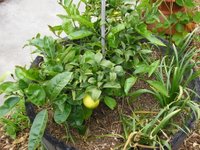
Citrus
My dwarf Meyer Lemon tree has only a couple not-quite-ripe lemons on it right now, but quite a few buds, so I'm hoping that it will continue to produce well (given its size). I'm considering getting a couple more citrus trees (perhaps a ruby red grapefruit and either a navel orange or a Satsumi tangerine) this fall to espalier along the fence in between the roses.
The mystery berry (raspberry? blackberry? black raspberry?) I found growing under the delphinium and moved to the new compost bed is doing OK, but I've decided to move it to a pot. For one thing, that will enable me to re-locate it to an area that gets sun all day. Also, since I plan on reworking the area where the compost beds are in the fall, I'd have to move them sooner or later anyway. I found a good, deep redwood pot yesterday and weird but interesting and functional metal store display thingie that will work well as a trellis. I hope to get it repotted in the next few days.
The only herbs I've planted so far are mint and lavender. The mint was planted last year and is doing great. I planted three lavender plants six weeks ago and although all three are growing at different rates, I think they'll all do fine.
Lettuces and Greens
Two wood pots of mesclun lettuces are sprouting away and I think I'll be able to start harvesting in a few weeks. The spinach I planted in a container is doing great, while the spinach starts I transplanted to the compost bed withered and died. (I've come to the conclusion that the compost I had delivered may have included a heavy proportion of pine needles and chips and therefore may be rather acidic.) I've also started a few cabbages from seed, which I will transplant to pots when they're a bit bigger. One of the great things about having these in pots is that I can keep the lettuces cool under the pergola on the deck and out of the path of nibbling pests.

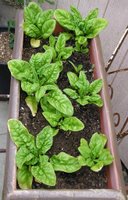
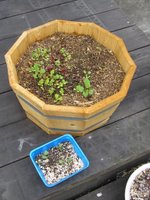
Beans and Peppers
I have two Roma bean plants that I started from seed and two Bell pepper plants I bought that are currently in the compost bed--and looking rather sickly. Again, I think this compost is just too acidic, so they're going to get transferred to pots. Hopefully, they'll perk up. I also want to start more of the Roma beans--I hope to get enough beans to freeze and I know that two plants won't produce that much.

The Romeo carrots I planted from seed in a container are doing well. I'm not sure when they'll be ready to harvest, but they're definitely growing. 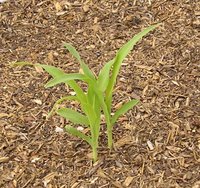
I've also found one thing at least that is happy to be in the compost bed--corn. I planted seeds a couple weeks ago and they're already a few inches high. After I take out the beans, peppers, and berry plant, I'm going to replant that bed with more corn, plus I'm going to build one more compost bed and seed that with corn as well.
I also took a chance with some baby dutch yellow potatoes that I bought at Trader Joe's and planted some of them in the compost bed as well. They should be OK with the acidic compost, and although I know it's recommended that you only plant certified seed potatoes and not the potatoes you buy in the grocery store, these potatoes were so delicious I thought I'd just give it a try. So far, nothing's sprouted, but I'm hopeful.
Conclusions
I know the extremely small scale of my farming efforts may be laughable to some, but I think things are working better this way than in past years when I've planted fewer types of vegetables, but more plants and gotten bumper crops that were hard to keep up with. Given my small gardening space and the fact that I'm a one-person household, I think I'll do better with smaller, rotating crops and an effort to keep something edible growing year-round. I've learned some tips from other blogs, especially The Path to Freedom Journal, that with the right techniques (container and vertical gardening, in particular), it's possible to get a good output no matter how big your gardening space is.


